Middleton W.M. (ed.) Reference Data for Engineers: Radio, Electronics, Computer and Communications
Подождите немного. Документ загружается.

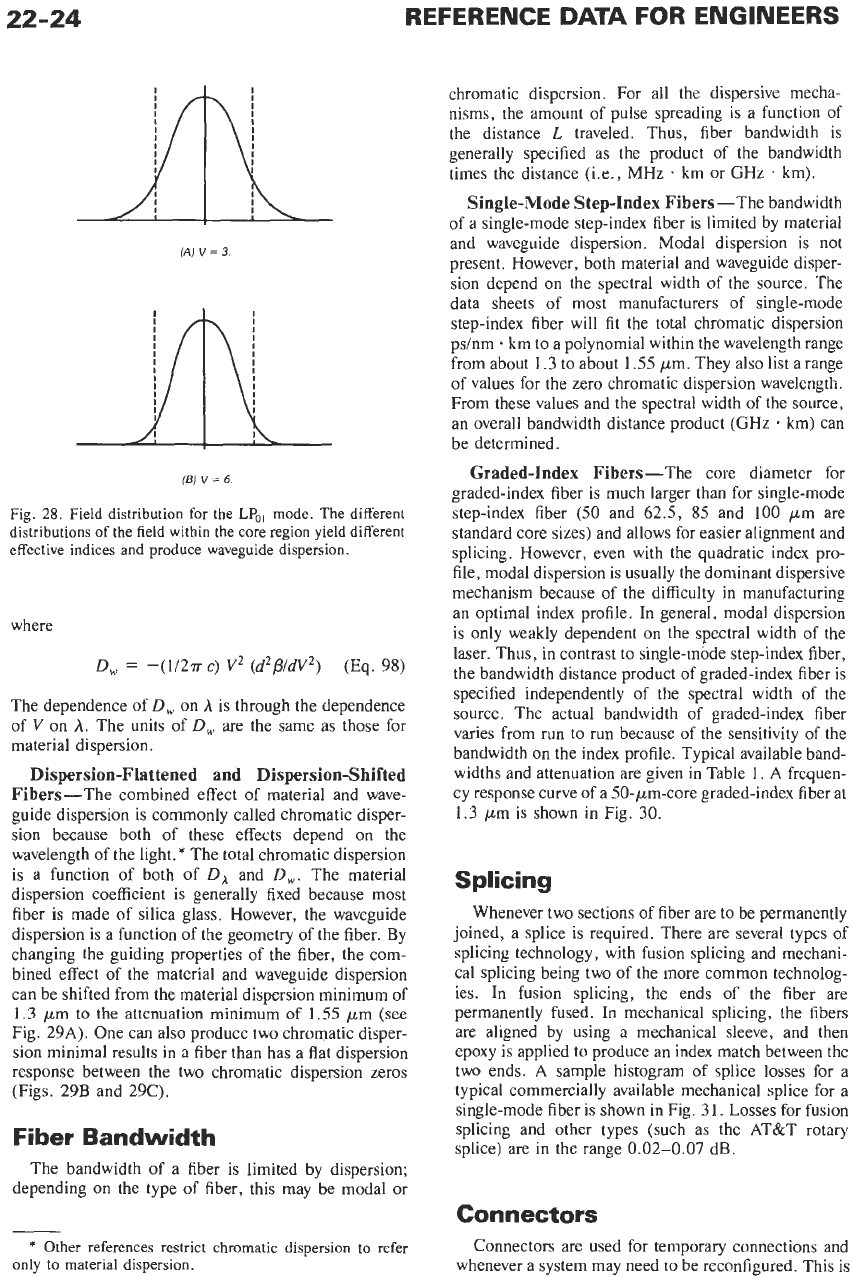
22-24
REFERENCE
DATA
FOR ENGINEERS
(AI
V
=
3
(E)
V
=
6
Fig.
28.
Field distribution for
the
LP,,
mode. The different
distributions
of
the
field
within
the
core region
yield
different
effective
indices
and
produce waveguide dispersion.
where
D,
=
-(1/2~
C)
V2 (d2p/dV2)
(Eq.
98)
The dependence of
D,
on
A
is through the dependence
of
V
on
A.
The units of
D,
are the same as those for
material dispersion.
Dispersion-Flattened and Dispersion-Shifted
Fibers-The combined effect of material and wave-
guide dispersion is commonly called chromatic disper-
sion because both of these effects depend on the
wavelength of the light.
*
The total chromatic dispersion
is a function of both of
D,
and
D,.
The material
dispersion coefficient is generally fixed because most
fiber is made
of
silica glass. However, the waveguide
dispersion is a function of the geometry of the fiber. By
changing the guiding properties of the fiber, the com-
bined effect of the material and waveguide dispersion
can be shifted from the material dispersion minimum of
1.3
pm
to the attenuation
minimum
of
1.55
pm
(see
Fig.
29A).
One can also produce two chromatic disper-
sion minimal results in a fiber than has a flat dispersion
response between the two chromatic dispersion zeros
(Figs.
29B
and
29C).
Fiber Bandwidth
The bandwidth of a fiber is limited by dispersion;
depending on the type of fiber, this may be modal
or
*
Other
references
restrict
chromatic dispersion
to
refer
only
to
material
dispersion.
chromatic dispersion. For all the dispersive mecha-
nisms, the amount of pulse spreading is a function of
the distance
L
traveled.
Thus,
fiber bandwidth is
generally specified as the product of the bandwidth
times the distance (i,e., MHz
.
km or GHz
.
km).
Single-Mode Step-Index Fibers-The bandwidth
of a single-mode step-index fiber is limited by material
and waveguide dispersion. Modal dispersion
is
not
present. However, both material and waveguide disper-
sion depend on the spectral width of the source. The
data sheets of most manufacturers of single-mode
step-index fiber will fit the total chromatic dispersion
ps/nm
*
km to a polynomial within the wavelength range
from about 1.3 to about
1.55
pm. They also list a range
of values for the zero chromatic dispersion wavelength.
From these values and the spectral width of the source,
an overall bandwidth distance product (GHz km) can
be determined.
Graded-Index Fibers-The core diameter for
graded-index fiber is much larger than for single-mode
step-index fiber
(50
and
62.5,
85
and
100
pm
are
standard core sizes) and allows for easier alignment and
splicing. However, even with the quadratic index pro-
file, modal dispersion is usually the dominant dispersive
mechanism because of the difficulty in manufacturing
an optimal index profile. In general, modal dispersion
is only weakly dependent on the spectral width of the
laser. Thus, in contrast
to
single-mode step-index fiber,
the bandwidth distance product of graded-index fiber
is
specified independently of the spectral width
of
the
source. The actual bandwidth of graded-index fiber
varies from run to run because of the sensitivity of the
bandwidth on the index profile. Typical available band-
widths and attenuation are given in Table
1.
A
frequen-
cy response curve of a 50-pm-core graded-index fiber at
1.3 pm is shown in Fig.
30.
Splicing
Whenever two sections of fiber are to be permanently
joined, a splice is required. There are several types of
splicing technology, with fusion splicing and mechani-
cal splicing being two of the more common technolog-
ies.
In
fusion splicing, the ends
of
the fiber are
permanently fused.
In
mechanical splicing, the fibers
are aligned by using a mechanical sleeve, and then
epoxy is applied to produce an index match between the
two ends.
A
sample histogram of splice losses for a
typical commercially available mechanical splice for a
single-mode fiber is shown in Fig. 31. Losses for fusion
splicing and other types (such as the AT&T rotary
splice) are in the range
0.02-0.07
dB.
Connectors
Connectors are used
for
temporary connections and
whenever a system may need to be reconfigured. This is
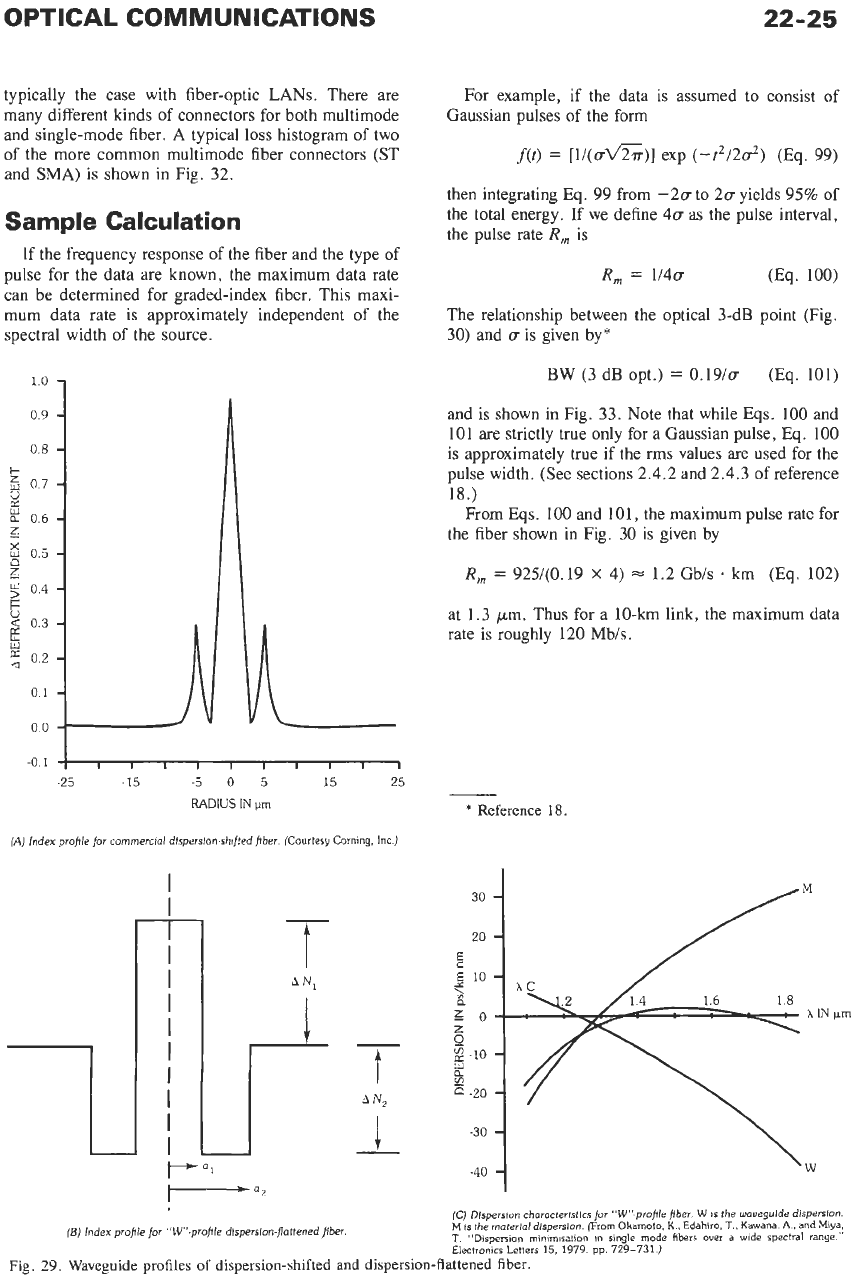
22-25
typically the case with fiber-optic LANs. There are
many different kinds
of
connectors for both multimode
and single-mode fiber. A typical loss histogram of two
of the more common multimode fiber connectors (ST
and SMA)
is
shown in Fig.
32.
Sample
Calculation
If the frequency response of the fiber and the type
of
pulse for the data are known, the maximum data rate
can be determined for graded-index fiber. This maxi-
mum data rate is approximately independent of the
spectral width of the source.
09
0.8
c
6
0.7
8
0.6
z
2
0.5
z
2
9
0.4
F
u
Q
0.3
0.2
E
iil
01
0.0
-25
-15
-5
0
5
15
25
For example, if the data is assumed to consist of
f(t)
=
[l/(u6)]
exp
(-t2/2d)
(Eq.
99)
then integrating
Eq.
99
from
-2u
to
2a
yields
95%
of
the total energy.
If
we define
4u
as the pulse interval,
the pulse rate R, is
Gaussian pulses of the form
R,
=
1I4u
(Eq.
100)
The relationship between the optical
3-dB
point (Fig.
30)
and
u
is given by*
BW
(3
dB opt.)
=
0.191~
(Eq.
101)
and is shown in Fig.
33.
Note that while
Eqs.
100 and
101
are strictly true only for a Gaussian pulse,
Eq.
100
is approximately true if the rms values are used for the
pulse width. (See sections
2.4.2
and
2.4.3
of reference
18.)
From
Eqs.
100
and
101,
the maximum pulse rate for
the fiber shown in Fig.
30
is given by
R,
=
925/(0.19
X
4)
=
1.2
Gb/s km
(Eq.
102)
at
1.3
pm. Thus for a IO-km link, the maximum data
rate is roughly
120
Mb/s.
RADIUS
IN
prn
*
Reference
18.
(A)
Index profile
for
commercial dispersion-shrfted fiber
(Courtesy
Corning, Inc
)
I
30
20
-30
-40
(C)
Dispersion chorocterlstlcs
for
"W'-profile
fiber
W
IS
the waneguide dispersion.
M
IS
the material dispersion.
From
Okarnoto.
K.,
Edahlro,
T.,
Kawana,
A,.
and
Miya.
T.
"Dispersion minimzsation in single mode
fibers
over
a
wide
spectral
range."
Electronics
Letters
15,
1979,
pp.
729-731
)
(E)
Index profile
for
"W'-profile dlspection-flalfened fiber.
Fig.
29.
Waveguide profiles
of
dispersion-shifted and dispersion-flattened fiber.
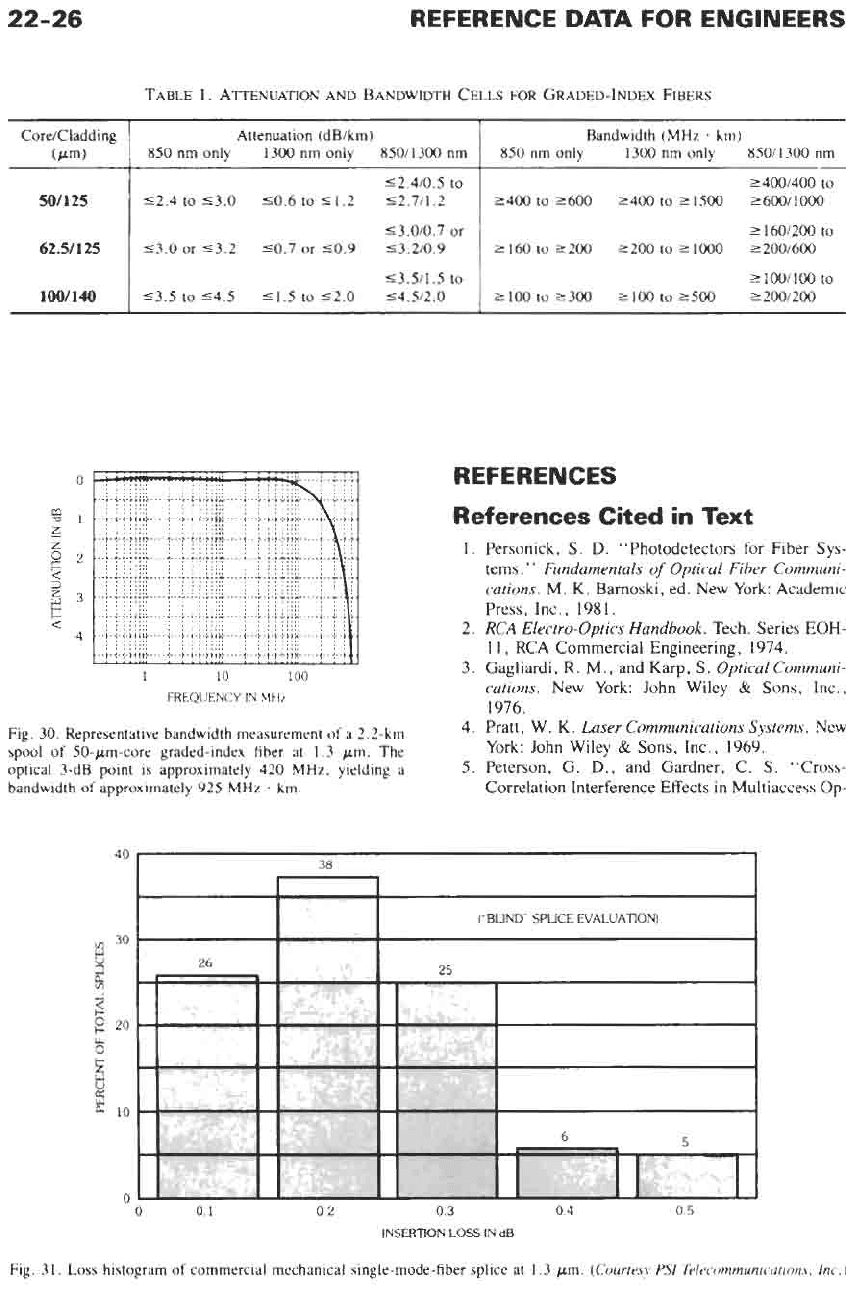
22-26
REFERENCE
DATA
FOR ENGINEERS
TABLE
1.
ATTENUATION
AND
BANDWIDTH CELLS
FOR
GRADED-INDEX
FIBERS
Attenuation (dB1km)
Bandwidth
(MHz
.
km)
Core/C1adding
(wm)
I
850 nm only 1300 nm only 85011300 nm
I
850 nm only 1300 nm only 85011300 nm
501125
62.51125
1001140
~~
5
2.410.5 to
52.4
to 53.0 50.6 to S1.2 52.111.2
s3.010.1
or
S3.0
or
53.2 50.7
or
50.9 53.U0.9
5331.5
to
~3.5
to
54.5 51.5 to 12.0 5432.0
2400/400
to
2400 to 2600
2400
to
21500
2600/1OOO
2
160/200 to
2160
to 2200
2200
to 2lOOO 2200/600
21001100 to
2100
to
2300 2100 to
2500
22001200
0
m
z
v
-1
z
g
-2
5
g
-3
-4
1
10
100
FREQUENCY
IN
MHz
Fig. 30. Representative bandwidth measurement
of
a 2.2-km
spool
of
50-pm-core
graded-index
fiber
at 1.3
pm.
The
optical 3-dB point is approximately 420
MHz,
yielding a
bandwidth
of
approximately 925
MHz
km.
REFERENCES
References
Cited
in
Text
1.
Personick,
S.
D.
“Photodetectors for Fiber
Sys-
tems.”
Fwtdamentals
of
Optical Fiber Communi-
cations.
M.
K.
Barnoski, ed. New York: Academic
Press,
Inc.,
1981.
2.
RCA
Electro-Optics
Handbook.
Tech.
Series EOH-
11,
RCA
Commercial Engineering,
1974.
3.
Gagliardi,
R.
M.,
and
Karp,
S. Optical Communi-
cations.
New York: John Wiley
&
Sons, Inc.,
1976.
4.
Pratt,
W.
K.
her Communications Systems.
New
York: John Wiley
&
Sons, Inc.,
1969.
5.
Peterson, G.
D.,
and
Gardner, C.
S.
“Cross-
Correlation Interference Effects in Multiaccess
Op-
40
3
30
1
8
10
a
s
2
20
4
0
0
0.1
0.2
0.3 04
0.5
INSERflON
LOSS
IN
dB
Fig. 31.
Loss
histogram
of
commercial mechanical single-mode-fiber splice at 1.3
pm.
(Courfesy
PSI
Telecommunications,
Inc.)
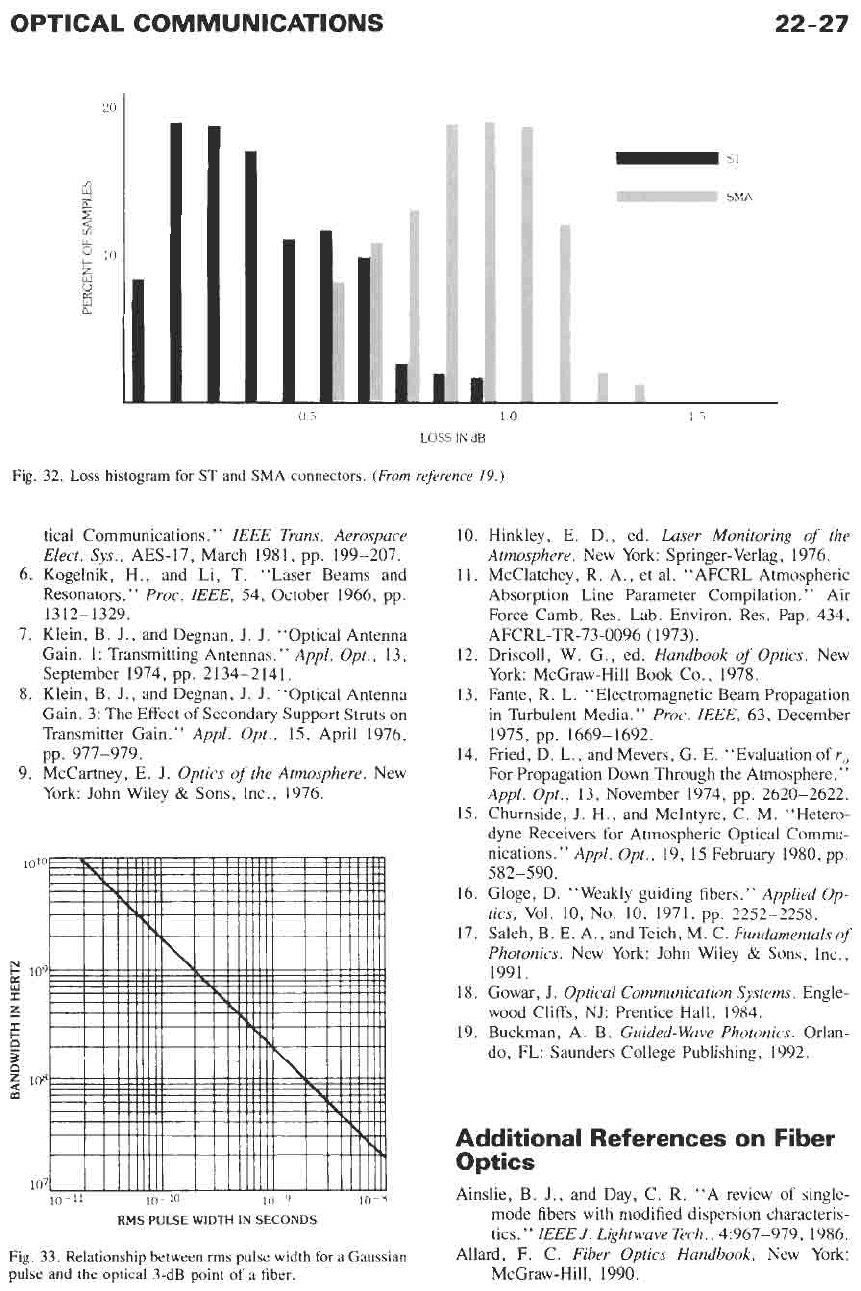
OPTICAL COMMUNICATIONS
20
I
Fig.
6.
7.
8.
9.
I
22-27
0.5
1.0
LOSS
IN
dB
32.
Loss
histogram
for
ST
and
SMA
connectors.
(From
refiereme
19.)
tical Communications.”
IEEE
Tmns.
Aerospace
Elect.
Sys.,
AES-17,
March
1981,
pp.
199-207.
Kogelnik,
H.,
and Li,
T.
“Laser
Beams and
Resonators.”
Proc. IEEE,
54,
October
1966,
pp.
13
12-1 329.
Klein, B. J., and Degnan, J. J. “Optical Antenna
Gain.
1:
Transmitting Antennas.”
Appl.
Opt.,
13,
September
1974,
pp.
2134-2141.
Klein, B. J., and Degnan, J.
J.
“Optical Antenna
Gain.
3:
The Effect of Secondary Support Struts on
Transmitter Gain.”
Appl. Opt.,
15,
April
1976,
McCartney, E. J.
Optics
of
the Atmosphere.
New
York: John Wiley
&
Sons, Inc.,
1976.
pp.
977-979.
RMS
PULSE
WIDTH
IN
SECONDS
Fig.
33.
Relationship between
nns
pulse width
for
a Gaussian
pulse and the optical
3dB
point
of
a
fiber.
1.5
10.
11.
12.
13.
14.
15.
16.
17.
18.
19.
Hinkley, E. D., ed.
Laser Monitoring
of
the
Atmosphere.
New Yok Springer-Verlag,
1976.
McClatchey,
R.
A., et al. “AFCRL Atmospheric
Absorption Line Parameter Compilation.” Air
Force Camb. Res. Lab. Environ. Res. Pap.
434,
AFCRL-TR-73-0096
(
1973).
Driscoll, W. G., ed.
Handbook
of
Optics.
New
York: McGraw-Hill Book Co.,
1978.
Fante, R. L. “Electromagnetic Beam Propagation
in Turbulent Media.”
Proc.
IEEE,
63,
December
Fried, D. L., and Mevers, G. E. “Evaluation
of
r,
For Propagation Down Through the Atmosphere.”
Appl. Opt.,
13,
November
1974,
pp.
2620-2622.
Churnside, J.
H.,
and McIntyre, C. M. “Hetero-
dyne Receivers for Atmospheric Optical Commu-
nications.”
Appl.
Opt.,
19,
15
February
1980,
pp.
582-590.
Gloge,
D.
“Weakly guiding fibers.”
Applied Op-
tics,
Vol.
10,
No.
10, 1971,
pp.
2252-2258.
Saleh, B.
E.
A., and Teich,
M.
C.
Fundamentals
of
Photonics.
New York: John Wiley
&
Sons,
lnc.,
1991.
Gowar, J.
Optical Comication Systems.
Engle-
wood
Cliffs, NJ: Prentice Hall,
1984.
Buckman, A. B.
Guided-Waw Photonics.
Orlan-
do, FL: Saundm College Publishing,
1992.
1975,
pp.
1669-1692.
Additional References on Fiber
Optics
Ainslie, B. J., and Day, C. R. “A review of single-
mode
fibers
with modified dispersion characteris-
tics.’’
IEEE
J.
Lightwave Tech.,
4:967-979, 1986.
AIM,
F.
C.
Fiber Optics Handbook,
New York:
McGraw-Hill,
1990.

22-28
REFERENCE
DATA
FOR ENGINEERS
Corning Glass.
Engineering Handbook.
New York:
Hecht,
J.
Understanding Fiber Optics.
Indianapolis:
Hentschel,
C.
Fiber Optics Handbook.
Hewlett Packard
Hoss,
R.
J.
Fiber Optic Communications.
Englewood
Cliffs,
NJ:
Prentice Hall, 1990.
Murata, H.
Handbook
of
Optical Fibers and Cables.
New York: Marcel Dekker, 1988.
Yeh,
C.
Handbook
of
Fiber Optics: Theory and Applica-
tions.
Orlando,
FL:
Academic Press, 1990.
Corning Inc., 1990.
Howard
W.
Sams
&
Co., 1987.
Company, Germany, 1988.
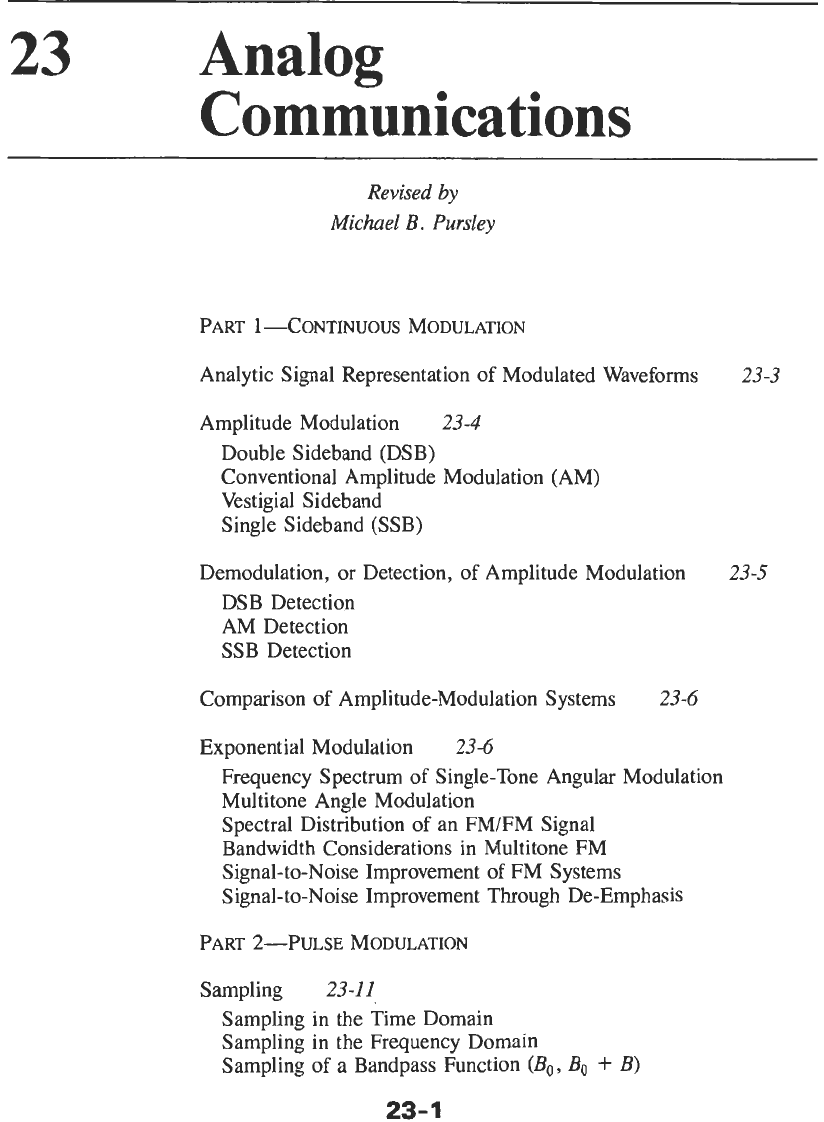
Analog
Communications
Revised
by
Michael
B.
Pursley
PART
1
-CONTINUOUS MODULATION
Analytic Signal Representation of Modulated Waveforms
23-3
Amplitude Modulation
23-4
Double Sideband (DSB)
Conventional Amplitude Modulation (AM)
Vestigial Sideband
Single Sideband (SSB)
Demodulation, or Detection, of Amplitude Modulation
23-5
DSB Detection
AM Detection
SSB Detection
Comparison of Amplitude-Modulation Systems
23-6
Exponential Modulation
23-6
Frequency Spectrum
of
Single-Tone Angular Modulation
Multitone Angle Modulation
Spectral Distribution of an FM/FM Signal
Bandwidth Considerations in Multitone FM
Signal-to-Noise Improvement
of
FM Systems
Signal-to-Noise Improvement Through De-Emphasis
PART 2-PULSE MODULATION
Sampling
23-11
Sampling in the Time Domain
Sampling in the Frequency Domain
Sampling of a Bandpass Function
(Bo,
BO
+
B)
23-1
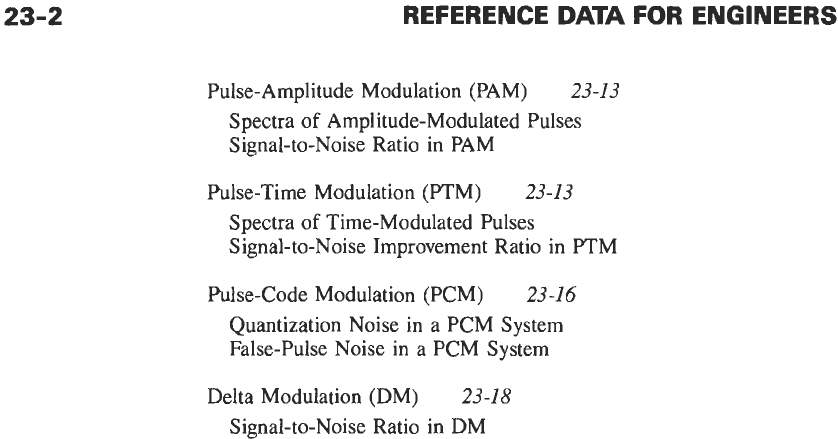
23-2
REFERENCE
DATA
FOR ENGINEERS
Pulse-Amplitude Modulation (PAM)
23-13
Spectra
of
Amplitude-Modulated Pulses
Signal-to-Noise Ratio in PAM
Pulse-Time Modulation (PTM)
23-13
Spectra
of
Time-Modulated Pulses
Signal-to-Noise Improvement Ratio in PTM
Pulse-Code Modulation (PCM)
23-16
Quantization Noise in a PCM System
False-Pulse Noise in a PCM System
Delta Modulation (DM)
23-18
Signal-to-Noise Ratio in DM
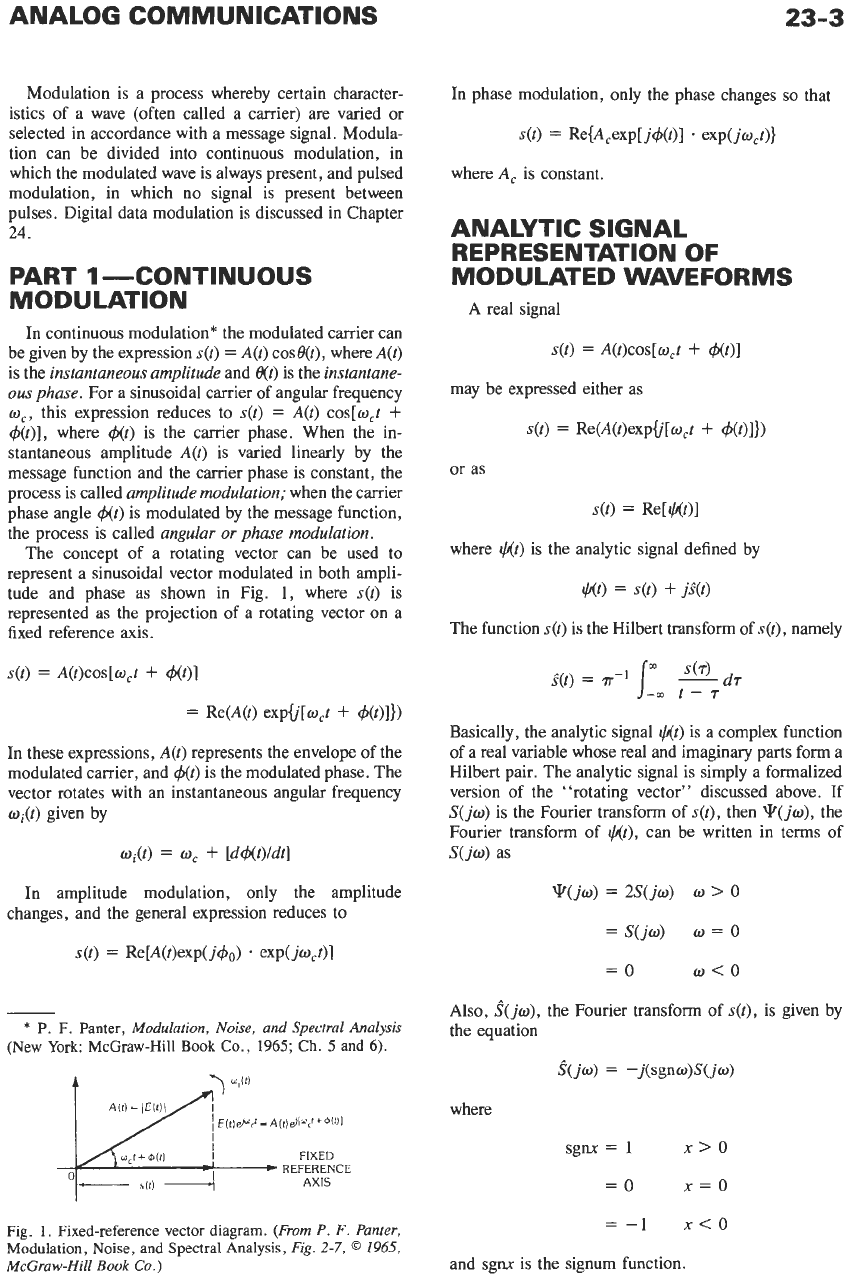
ANALOG COMMUNICATIONS
23-3
Modulation is a process whereby certain character-
istics of a wave (often called a carrier) are varied or
selected in accordance with a message signal. Modula-
tion can be divided into continuous modulation, in
which the modulated wave is always present, and pulsed
modulation, in which no signal
is
present between
pulses. Digital data modulation is discussed in Chapter
24.
PART
1
-CONTINUOUS
MODULATION
In continuous modulation* the modulated carrier can
be given by the expression
s(t)
=
A(t) cosO(t), where A(t)
is the instantaneous amplitude and
e(t)
is the instantane-
ous
phase. For a sinusoidal carrier of angular frequency
w,,
this expression reduces to
s(t)
=
A(t) cos[w,t
+
4(t)], where &t) is the carrier phase. When the in-
stantaneous amplitude
A(t)
is varied linearly by the
message function and the carrier phase is constant, the
process is called amplitude modulation; when the carrier
phase angle &t)
is
modulated by the message function,
the process is called angular
or
phase modulation.
The concept of a rotating vector can be used to
represent a sinusoidal vector modulated in both ampli-
tude and phase as shown in Fig.
1,
where
s(t)
is
represented as the projection of a rotating vector on a
fixed reference axis.
s(t)
=
A(t)cos[w,t
+
I$@)]
=
ReM) expCiIw,t
+
4401))
In these expressions, A(t) represents the envelope of the
modulated carrier, and &t) is the modulated phase. The
vector rotates with an instantaneous angular frequency
wi(t)
given by
wi(t)
=
w,
+
[d4(t)/dt]
In amplitude modulation, only the amplitude
changes, and the general expression reduces to
s(t)
=
Re[A(t)eXp(j40)
.
exp(jw,t)l
*
P.
F.
Panter,
Modulation, Noise, and Spectral Analysis
(New
York: McGraw-Hill Book
Co.,
1965;
Ch. 5
and
6).
FIXED
REFERENCE
Fig.
1.
Fixed-reference vector diagram.
(From
P.
F.
Panter,
Modulation,
Noise,
and Spectral Analysis,
Fig.
2-7,
0
1965,
McGraw-Hill
Book
Co.)
In phase modulation, only the phase changes
so
that
s(t)
=
Re{ACexp[j4(t)l exp(jw,t))
where
A,
is constant.
ANALYTIC SIGNAL
REPRESENTATION
OF
MODULATED WAVEFORMS
A
real signal
s(t)
=
A(t)cos[w,t
+
&t)]
may be expressed either as
where
Nt)
is the analytic signal defined by
+(t)
=
s(t)
+
ji(t)
The function
s(t)
is the Hilbert transform of
s(t),
namely
Basically, the analytic signal fit) is a complex function
of a real variable whose real and imaginary parts form a
Hilbert pair. The analytic signal is simply a formalized
version of the “rotating vector” discussed above.
If
S(jw)
is the Fourier transform of
s(t),
then
W(jw),
the
Fourier transform of
fit),
can be written in terms of
S(jw)
as
T(j0)
=
2S(jw)
0
>
0
=
S(jw)
w
=
0
=o
w<o
Also,
$jw),
the Fourier transform of
s(t),
is given by
the equation
$jw)
=
-j(sgnw)S(jw)
where
sgnx=1
x>O
=o
x=o
=
-1
x<o
and sgnx is the signum function.

23-4
REFERENCE DATA FOR ENGINEERS
AMPLITUDE MODULATION
In amplitude modulation, the frequency components
of the modulating signal are translated
to
occupy a
different position in the spectrum. It is essentially a
multiplication process in which the time functions that
describe the modulating signal and carrier are multi-
plied together. The following amplitude-modulation
systems are discussed.
(A)
Double-sideband suppressed carrier (DSB-SC),
(B) Conventional amplitude modulation
(AM)
(C)
Vestigial sideband
(D) Single sideband
(SSB)
also called DSB
Double Sideband (DSB)
In
DSB
modulation, the message signal
g(t),
whose
Fourier transform
is
G(jo),
is
considered to have zero
dc component. The product
e(t)
=
A,g(t)
coso,f
represents a double-sideband suppressed-carrier signal,
and
A,
=
amplitude of unmodulated carrier. The
radio-frequency envelope follows the waveform of the
modulating signal
g(t)
as shown in Fig.
2.
The spectral
components of the DSB signal
e(t)
are
given by its
Fourier transform
E(jw)
=
&G[j(w
-
a,)]
+
&G[j(o
+
w,)]
as shown in Fig.
3.
Note that the upper and lower
sidebands are translated symmetrically
rf:
w,
about the
origin.
Conventional Amplitude
Modulation (AM)
In
amplitude modulation, a dc term is added to the
modulating signal
g(t).
The resulting waveform, shown
Fig.
2.
Double-sideband waveforms.
(From
P.
F.
Punter,
Modulation, Noise,
and
Spectral
Analysis,
Fig.
5-3,
@
1965,
McGraw-Hill
Book
Co.)
LOWER
UPPER
SIDEBAND SIDEBAND
-wc-u* -wc
-w,+wb
0
Wc-Wb
wc
W,+Wb
Fig.
3.
Baseband signal
and
double-sideband spectra.
(From
P.
F.
Panter,
Modulation, Noise, and Spectral Analysis,
Fig.
5-2,
0
1965,
McGraw-Hill
Book
Co.)
in Fig.
4,
is given by
e(t)
=
[Ao
+
as(t)]coso,t
=
A0
[l
+
~,s(~)]coso,~
where,
a
=
maximum amplitude of modulating function,
g(t)
=
as@),
ls(t)l
5
1,
m,
=
n/Ao
=
modulation index or degree of
A,,
=
amplitude of unmodulated carrier,
Imp
(t)l
modulation,
0
5
mu
5
1,
5
1,
to ensure an undistorted envelope.
Vestigial Sideband
Vestigial-sideband modulation is derived from a DSB
signal by passing the output of the product modulator
through a filter whose transfer function is
H,(jo),
as
shown in Fig.
5.
The transfer function
H,(jo)
of the
filter treats the two sidebands of the DSB signal in such
a manner as to attenuate one sideband differently from
the other. The process of vestigial-sideband modulation
by the use of the filter network
H,(jo)
may be replaced
by the equialent vestigial system shown in Fig.
6,
where
the transfer functions
H,(jo)
and
H,(jo)
are given by
Hi(jo)
=
2Hv[j(w
-
W,)I
+
H,M~
+
o,)I)
H,(j4
=
(W){HJj(@
-
o,)l
-
H,[Ao
+
oJl)
Single Sideband
(SSB)
Single-sideband transmission may be produced in the
same manner as vestigial sideband by using a high-pass
filter
H,(jw)
which completely eliminates all signals on
one side of the carrier frequency. The transfer function
H,(jw)
of the ideal high-pass filter
is
defined by
H,(.i4
=
['
+
1
2
sgn(w
-
41
+
rt
-
;
sgn(o
-
%)I
2
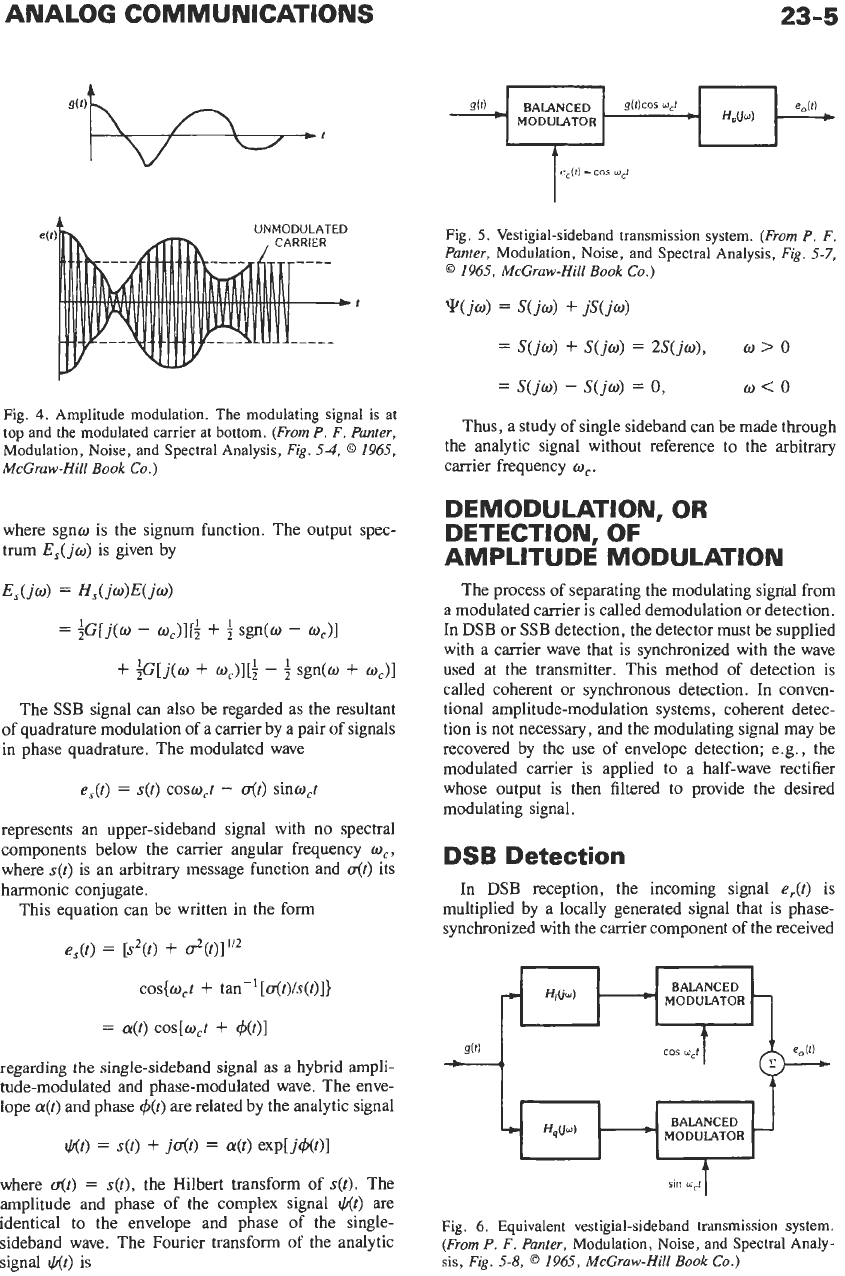
ANALOG COMMUNICATIONS
23-5
Fig.
4.
Amplitude modulation.
The
modulating signal
is
at
top
and the
modulated carrier
at
bottom.
(From P.
F.
Punter,
Modulation, Noise, and Spectral Analysis,
Fig.
54.
@
1965,
McGraw-Hill
Book
Co.)
where sgnw is the signum function. The output spec-
trum
E,(jw)
is given by
E,(jd
=
HS(j4E(jw)
=
iG[j(w
-
w,)][4
+
4
sgn(o
-
w,)]
+
i~[j(w
+
o,)l[f
-
f
sgn(w
+
w,)]
The
SSB
signal can also be regarded as the resultant
of
quadrature modulation of a carrier by a pair of signals
in phase quadrature. The modulated wave
e,@)
=
s(t)
COSW,~
-
dt)
sinw,t
represents an upper-sideband signal with no spectral
components below the carrier angular frequency
a,,
where
s(t)
is an arbitrary message function and
dt)
its
harmonic conjugate.
This equation can be written in the form
e,(t)
=
[s2(t)
+
d2(t)11'*
cos{w,t
+
tan-' [a(t)/s(t)]}
=
a(t)
cos[w,t
+
+(t)]
regarding the single-sideband signal as a hybrid ampli-
tude-modulated and phase-modulated wave. The enve-
lope
a(t)
and phase
&t)
are related by the analytic signal
fit)
=
s(t)
+
jdt)
=
4)
exp[j&t)l
where
dt)
=
s(t),
the Hilbert transform of
s(t).
The
amplitude and phase of the complex signal
fit)
are
identical to the envelope and phase
of
the single-
sideband wave. The Fourier transform of the analytic
signal
fit)
is
e&)
=cos
WCt
7-
Fig.
5.
Vestigial-sideband transmission system.
(From P. F.
Punter,
Modulation, Noise, and Spectral
Analysis,
Fig.
5-7,
@
1965, McGraw-Hill
Book
Co.)
V(jw)
=
S(j0)
+
jS(jw)
=
S(jw)
+
S(jw)
=
2S(jw),
w
>
0
=
S(j0)
-
S(j0)
=
0,
w<o
Thus, a study of single sideband can be made through
the analytic signal without reference
to
the arbitrary
carrier frequency
w,.
DEMODULATION,
OR
DETECTION,
OF
AMPLITUDE MODULATION
The process
of
separating the modulating sigrial from
a modulated carrier is called demodulation or detection.
In DSB or
SSB
detection, the detector must be supplied
with a carrier wave that is synchronized with the wave
used at the transmitter. This method
of
detection is
called coherent or synchronous detection. In conven-
tional amplitude-modulation systems, coherent detec-
tion is not necessary, and the modulating signal may be
recovered by the use
of
envelope detection; e.g., the
modulated carrier is applied to a half-wave rectifier
whose output is then filtered
to
provide the desired
modulating signal.
DSB Detection
In DSB reception, the incoming signal
e,@)
is
multiplied by a locally generated signal that is phase-
synchronized with the carrier component of the received
BALANCED
MODULATOR
H&J)
w
sin
iict
Fig.
6.
Equivalent
vestigial-sideband transmission system.
(From P. F. Punter,
Modulation,
Noise, and
Spectral Analy-
sis,
Fig.
5-8,
@
1965, McGraw-Hill
Book
Co.)
